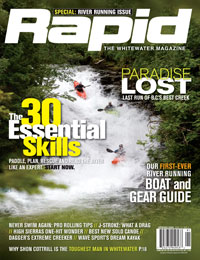Days before, local reports on the Marmora Area Canoe and Kayak Festival website said Beaver Creek was still frozen. At 3 p.m. when we finally arrive, however, the water beneath the take-out bridge is running high and fast.
We head to the put-in eight kilometres upstream—no shuttle arranged, agreeing that we’ll walk back to the truck if we have to.
The Beaver is considered an intermediate to advanced class III-IV run, one you could run in four hours but typically stretch to a full day. Now 3:30 on a cold, sleeting early spring afternoon, we need to hustle to get down before dark.
At the bottom of Triple Drop, the first significant rapid, the Beaver slips away from us beneath a layer of spongy ice. The half-frozen crust is thick enough to support the surface area of our boats, but not enough that we can walk on top without falling through. After a kilometre of poling with paddles and swinging our boats beneath our arms as if on parallel bars, we face an icy crossroads.
Straight ahead as far as we can see is another 500 metres of ice. To the right a flooded but open channel dekes into the woods. We figure with the 50-year record high water and the constriction of ice below, this temporary channel will link back to the Beaver’s main flow.
After the first couple kilometres of fast-moving class I and II we know we’ve left the Beaver for good. We also know that we are well past the point of no return. Joking of a new first descent, we continue threading our way down through flooded hardwood forest.
Finally, at the intersection of an old train bridge and hydro line corridor, we climb up to take a look. Beyond the bridge the swollen creek feeds through dense bush, thick and constrictive as a kitchen strainer.
We guess we have an hour of daylight left, tops. Eating the last of our lunches and weighing our options, we thank God that our wives and girlfriends aren’t here. Infrequent faint rumbling of heavy equipment off to the right urges us to begin dragging our boats in this direction, away from the river.
By the time we reach a log landing, the skidder crews have long gone home. We continue hiking, boats now scraping along a muddy bush road, until we reach the end of a country road and the home of Dianne MacDonald. Dianne is feeding her birds when her flashlight bounces off the reflective strips on my drysuit.
“Are you guys kayakers?”
“Yes.”
“What in Lord’s name are you doing in my yard?”
Too difficult to explain.
Dianne feeds us cookies and hot tea, loads us in the back of her deceased husband’s Dodge Dakota and drives us 22 kilometres back to where we had set off to almost run the Beaver.
Hunkered down out of the wind and sleet we’re giddy with our good fortune. It turns out that continuing past the bridge would have meant two kilometres of bush-crashing leading into a 100-acre swampy meadow. Dragging our boats in the other direction would have taken us down 16 kilometres of snowmobile trails before reaching Beaver Creek.
Even with a river full of ice, missing the run entirely, hiking out in the dark and hitching a ride with a kindly widow, we agree this is river running at its best—exploration, camaraderie and adventure. You just don’t find this in a man-made whitewater park.
“I certainly hope you boys have learned your lesson,” Dianne warns, waving and driving away.
“Oh yes, ma’am,” we shout. Knowing full well we haven’t.
Scott MacGregor is the publisher of Rapid, Adventure Kayak, Canoeroots and Kayak Angler magazine. This year on the Beaver he’ll be carrying a compass and wearing shoes.




